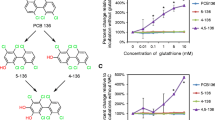Abstract
The effect of several experimental conditions on methane (CH4) production from dimethylsulfoxide (DMSO) in incubation mixtures containing liver microsomes and NADPH generating systems was studied. The process was heat sensitive in part but a significant fraction was non-enzymatic in nature. CH4 formation from DMSO was not significantly modified by 2-diethylaminoethyl-2,2-diphenylvalerate. HC1 (SKF 525 A) or EDTA 1 mM and significantly enhanced under an atmosphere of (CO 80%+O2 20%) rather than under air. A marked increase in CH4 production was observed when paraquat (PQ) was included in incubation mixtures but not when nifurtimox (Nfx) was added. Results support the hypothesis of hydroxyl free radical (·OH) formation during PQ biotransformation but cast doubts about its production for the case of Nfx. The low temperature gas chromatographic separation of d3-CH4 from CH4 described opens the future possibility for detecting trace formation of ·OH in vivo, without interference from fecal CH4 formation by administering d6-DMSO to animals and collecting exhaled gases produced, in chambers containing the entire animal.
Similar content being viewed by others
References
Aguilar EG, Arranz CK de, Toranzo EGD de, Castro JA (1985) Benznidazole and Nifurtimox nitroreductase activity in liver microsomes from male rats pre-induced with phenobarbital or 3-methylcholanthrene. Res Commun Chem Pathol Pharmacol 50: 443–446
Baldwin RC, Pasi A, MacGregor JT, Hine CM (1975) The rates of radical formation from dipyridilium herbicides, paraquat, diquat and morfamquat in homogenates of rat lung, kidney and liver. Toxicol Appl Pharmacol 32: 298–304
Bancroft H (1960) Introduction a la bioestadística. EUDEBA, Buenos Aires, pp 205–211
Bernacchi AS, Castro CR de, Toranzo EGD, Castro JA (1986) Effects of nifurtimox or benznidazole administration on rat testes: ultrastructural observations and biochemical studies. Exp Mol Pathol 45: 245–256
Bus JS, Gibson JE (1984). Paraquat: model for oxidant initiated toxicity. Environ Health Perspect 55: 37–46
Cadenas E, Brigelius R, Sies H (1983) Paraquat-induced chemiluminiscence of microsomal fractions. Biochem Pharmacol 32: 147–150
Castro GD, Castro JA (1985) Studies on pentane evolution by rats treated with nirfurtimox or benznidazole. Toxicology 35: 319–326
Castro JA, Gillette JR (1967) Species and sex differences in the kinetic constants for the N-demethylation of ethyl morphine by liver microsomes. Biochem Biophys Res Commun 28: 426–430
Castro JA, Toranzo EGD de (1988) Toxic side effects of nifurtimox and benznidazole, two drugs used against American Trypanosomiasis (Chagas' Disease). Biomed Environ Sci (in press)
Cohen G, Cederbaum AI (1979) Chemical evidence for production of hydroxyl radicals during microsomal electron transfer. Science 204: 66–68
Docampo R, Mason RP, Mottley C, Muniz RPA (1981a) Generation of free radicals induced by nifurtimox in mammalian tissues. J Biol Chem 256: 10930–10933
Docampo R, Moreno SNJ (1985) Biochemical toxicolgy of antiparasitic compounds used in the chemotherapy and chemoprophylaxis of American Trypanosomiasis (Chagas' Disease). Rev Biochem Toxicol 7: 159–204
Docampo R, Moreno SNJ, Stoppani AOM (1981b) Nitrofuran enhancement of microsomal electron transport, superoxide anion production and lipid peroxidation. Arch Biochem Biophys 207: 316–324
Dubin M, Grinblat L, Fernández Villamil SH, Stoppani AOM (1987a) Inhibición de la lipoperoxidación en microsomas de hígado por Nifurtimox y Nitrofurantoína. Medicina 47: 342–350
Dubin M, Grinblat L, Fernández Villamil SH, Stoppani AOM (1987b). Nitrofuran inhibition of microsomal lipid peroxidation. FEBS Lett 220: 197–200
Dubin M, Moreno SNJ, Martino EE, Docampo R, Stoppani AOM (1983) Increased biliary secretion and loss of hepatic glutathione in rat liver after nifurtimox treatment. Biochem Pharmacol 32: 483–487
Fairshter RD, Vaziri ND, Dearden LC, Malott K, Caseño M (1984) Effect of dimethylthiourea on paraquat toxicity in rats. Toxicol Appl Pharmacol 74: 150–154
Klein SM, Cohen G, Cederbaun AI (1981) Production of formaldehyde during metabolism of dimethylsulfoxide by hydroxyl radical generating systems. Biochemistry 20: 6006–6012
Repine JE, Eaton JW, Anders MW, Hoidal JR, Fox RB (1979) Generation of hydroxyl radical by enzymes, chemicals, and human phagocytes in vitro. J Clin Invest 64: 1642–1651
Smith LL (1985) Paraquat toxicity. Philos Trans R Soc Lond B 311: 647–657
Smith LL (1987) Mechanism of paraquat toxicity and its relevance to treatment. Hum Toxicol 6 (Suppl): 31–36
Author information
Authors and Affiliations
Additional information
This work was supported by Grant AM 13 195-18 from the National Institutes of Health (USA)
Rights and permissions
About this article
Cite this article
Castro, G.D., Lopez, A. & Castro, J.A. Evidence for hydroxyl free radical formation during paraquat but not for nifurtimox liver microsomal biotransformation. A dimethyl-sulfoxide scavenging study. Arch Toxicol 62, 355–358 (1988). https://doi.org/10.1007/BF00293623
Received:
Accepted:
Issue Date:
DOI: https://doi.org/10.1007/BF00293623




